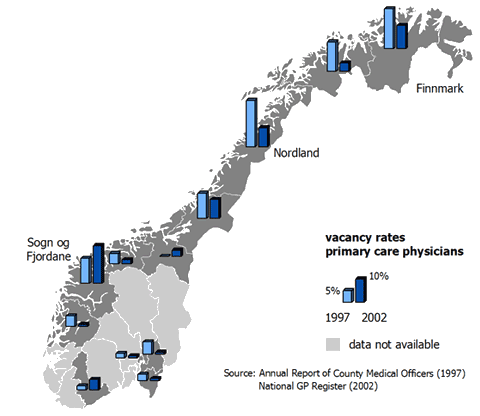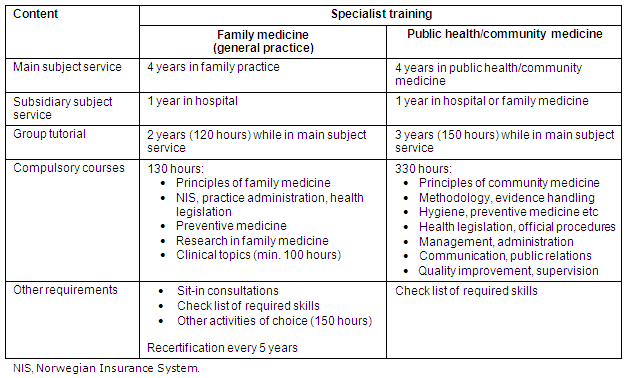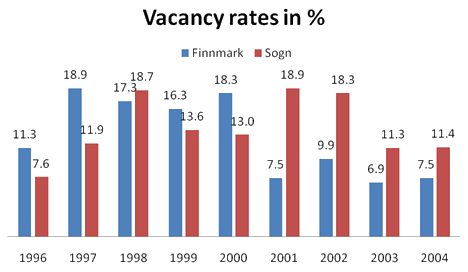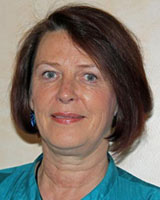Introduction
Recruitment and retention of qualified health professionals, especially physicians, is a major challenge in health service delivery in the high north, similar to other remote areas of the world. Lack of professional support and possibilities for professional development have been reported by young doctors as the major reasons for abandoning work in remote areas1. This article describes a strategy to address this problem and evaluates the effect of the strategy for Finnmark, the northernmost county of Norway.
Context
Finnmark is situated far north of the Polar Circle and faces a harsh climate. The county covers an area larger than Switzerland with only 73 000 inhabitants, most of whom are concentrated in fishing villages along the coast, and rural settlements with a predominant population of Sami (Indigenous) semi-nomads in the inland. The population, especially in remote settlements, has decreased rapidly over the last 20 years, mostly due to lower birth rates and young people moving out to seek higher education and better career opportunities. The population also suffers more health problems2 and shorter life expectancy than the national average3.
Even though Norway is a high income country with one of the highest health worker densities in Europe4, there has long been an urban-rural health worker maldistribution. Rural health workforce shortages, especially of physicians, have been recurring since the 1960s5, and Finnmark has suffered the most severe problems6. Figure 1 illustrates the geographical distribution of recruitment/retention challenges; the densely populated areas in south and east are well staffed, while the north and one county in the west have high vacancy rates. In spite of retention policies such as special allowances and loan pay-back schemes, a new crisis peaked in Finnmark in 1997 with 23% of the positions for primary care physicians being vacant and an additional 15% being on long-term leave7. This 38% shortage was partly alleviated on a week-to-week basis by foreign locums, who were not necessarily prepared for the specific challenges of the county.

Figure 1: Geographical distribution of primary care physician vacancies in Norwegian counties.
In accordance with a study that found professional support and career development to be more important for retention than income1, a search for sustainable strategies connected to the ordinary training schemes was encouraged.
Postgraduate training (vocational training/residency)
Postgraduate training for physicians in Norway is organized by the Norwegian Medical Association on behalf of the government (a political decision has been made to change this in the future) (Table 1). The training is carried out in various locations, supervised by one national committee for each of the 44 recognized specialties.
Table 1: Summary of medical undergraduate and postgraduate training in Norway

When general practice/family medicine (FM) and public health (PH)/community medicine were recognized as full specialties in 1985, one of the main principles was to design training curricula that could be conducted in-service throughout the country, including remote areas8 to avoid centralization of the primary care physicians while in training.
The curricula is a 5 year program of 4 years in FM/PH and one year in hospital. There are specific requirements for mandatory courses and skills to master. The major element of the program is, however, the tutorial groups, accompanying the in-service training (2 years in FM and 3 years in PH). The groups meet bi-weekly or once a month (for a whole day) if travelling distances are large. Approximately half of the topics covered are mandatory, and are informed by electronically available handbooks offering suggestions for the meetings, including preparation and reading. The other half of the sessions, mainly clinical topics, is decided by the groups themselves according to the specific learning needs of group members. The groups are facilitated by a senior primary care physician, specially trained in group tutorage. The curricula are summarized (Table 2).
Table 2: Summary of Norwegian requirements for specialist training in family medicine and public health

Methods
Intervention method
Although the FM/PH training model has been implemented nationwide since 1985, it had not been fully explored as a tool for retention. Responding to the critical shortage of physicians in Finnmark in 1997, it was decided to employ the tutorial groups in a systematic and determined way to enhance retention. New efforts were made to recruit interns to vacant positions in the county after finishing their internship9. On recruitment, the intern is offered admission to an FM or PH training group, providing the professional support they need to feel confident working in a remote place.
In Finnmark some of the trainees have to travel more than 500 km each way to attend group meetings. The trainees are permitted to attend the groups merely for professional support if they wish and are not obliged to sign up for the complete specialization program. In the PH group, trainees are permitted to continue attending group meetings beyond the compulsory 3 year program if they still want the professional support.
All expenses for training activities, including travel costs, are covered by government funding. The groups also promote networking with experienced primary care physicians in the county, and the Medical Association of Finnmark supports the training system by organizing biannual courses, mandatory in the GP training and the recertification program. Together these professional structures provide important social and networking venues for young doctors settling far from family and friends.
Evaluation methods
Cohorts of postgraduate trainees in Finnmark have been tracked in a longitudinal study since 1995. The PH group tutor and the coordinator of the FM groups keep records of trainees admitted to and leaving the different groups. Because the county employs less than 100 primary care physicians, it is easy to keep track of those leaving and those retained. In the few cases of lost contact, supplementary enquiry to the municipal authorities provided the necessary information.
Norway has undergone substantial health system changes regarding doctors' working conditions and the labour market during the period of observation. Hence a simple before-and-after analysis would not be appropriate to measure the effects of the strategies. The study commenced with Nordland, another remote county situated around the Polar Circle, as a 'control group' in 1997. However this area was also affected by the crisis6, and as some of the same strategies were implemented in 1998, the control county was lost to the study. However, some parallels can be drawn retrospectively to another rural county that has also faced retention problems. Figures for this comparison were obtained from annual reports provided by the respective County Medical Offices 10.
In order to evaluate the retention effect of the training program, retention rate defined as 'still working in Finnmark 5 years after completion of the compulsory group tutorage' was considered to be the most illustrative variable. The specific reason for choosing 5 years was that the training curricula for both FM and PH are normally fulfilled in 5 years, including one year of hospital practice. The hospital year is often critical for retention, for when physicians leave the county for this practice, some never return. However, those who do return (or complete their hospital practice in one of the two small hospitals in Finnmark) tend to settle in the area. Five years after completion of group tutorage usually means 2-3 years after completing the full specialization curriculum. It is thereby a good indicator for long-term retention.
Results
Public health/community medicine training
During the years 1995-2008, a total of 40 doctors were admitted to the PH group, and by the end of 2008, 28 of them (70%) were still working in Finnmark. Only four (one woman and three men) have so far fulfilled the complete specialization program, while the remaining 36 only wanted professional support for a shorter or longer period of time (eight have been attending the group for more than 8 years and continue to do so).
As these figures show, some doctors have stayed for 14 years or more, while others have stayed for shorter periods. For 15 of the doctors, more than 5 years had passed since the completion of the three mandatory years of tutelage. Of these, 10 are still working in Finnmark, comprising a five-year retention rate of 67%.
General practice/family medicine training
The results of the FM training has been assessed on two different occasions. In the years 1997-2001 a total of 36 doctors from Finnmark (13 women and 23 men) were admitted to FM training groups. According to the first count in the summer of 2003 when the last of these groups completed their tutorial, 29 (80%) were still working in Finnmark. Five years after the completion of their group (five-year retention) two of the doctors were deceased and one was not working for other reasons. Of the remaining 33 still working, 20 (eight women and 12 men) are in Finnmark, giving a five-year retention rate of 60%.
In the years 2002-2006, another 36 (12 women and 24 men) were admitted to new groups. By the end of 2008 when the last of these groups completed the program, 24 of the participants (67%) were still working in Finnmark. Only four of these doctors completed their tutorial more than 5 years ago, and all of them (two women and two men) are still working in Finnmark. Added to the cohort above, this gives an overall five-year retention rate of 65%.
Some doctors (11) who attended tutorial group in both FM and PH during this period were counted in both settings. This does not change the retention rates for the respective training programs, only the total number of primary care physicians retained in Finnmark, which has not been a subject to this evaluation.
Impact for the county
Vacancy rate is the most the commonly used entity to measure of recruitment/retention problems in Norwegian statistics. During the observation period discussed, the vacancy rates for primary care physicians in Finnmark has improved. Comparison with the vacancy rates of another remote county (Sogn-and-Fjordane on the west coast) in the same time period was believed to offer a relevant comparison(Fig2).

Figure 2: Vacancy rates for primary care physicians in two rural Norwegian counties.
In Sogn-and-Fjordane, the physician shortage did not receive the same attention during the 1990s and the vacancy rate continued to increase; however, upon the intervention it started to reduce in Finnmark. In 2002 when the problem addressed in Sogn-and-Fjordane11 using approaches similar to those in Finnmark, the vacancy rate started to reduce.
Discussion
It is not claimed that the tutorial groups are the only reason for improved retention. Professional support is, however, a crucial element of retention programs in Norway. Finnmark typically recruits young doctors before they go into postgraduate training; older doctors coming as fully accredited specialists in FM or PH are exceptional. Almost all the newcomers enter one or both of the training programs. Of the 80-90 primary care physicians working in Finnmark today, there is only a handful who have not completed or is currently in one of the programs in this county. With this background the five-year retention rate of 65-67% is satisfactory.
There may be a number of reasons for this success:
- The training groups provide the professional support needed by young doctors to be confident when working in remote areas.
- The curriculum is flexible and meets the learning needs of the trainees. Tutorial groups in rural areas can include clinical topics of specific relevance to their practice. Lawrance12 considers this 'vertical integration' (adequate exposure to the needed skills and the environment in which they will be used) key training for rural general practice.
- The training model permits the training to be conducted in-service in remote areas. This allows trainees and their families to 'grow roots' in the rural communities during the training period.
- The groups offer an opportunity to create a professional network in the region that will rescue the doctors from professional isolation in the years to come.
- The model includes a re-certification program requiring continuous medical education, which also can be carried out in remote areas.
- The training model is not a 'special offer' for rural and remote areas. The same scheme is conducted all over the country and the specialist accreditation is valid everywhere.
This training model does not produce 'second class' doctors: the challenging rural medical practice provides excellent conditions for learning, when supported by appropriate tutelage. According to modern principles of adult learning, training should be problem-based and attached to real-life situations, and rural practice offers excellent opportunities for such training.
In many countries postgraduate training is characterized by a centralistic and conservative education philosophy. Other countries like Canada13 and Australia14 have developed 'rural pipelines' for medical education and rural family medicine streams for postgraduate training during the last couple of decades. Evaluations have shown that rural postgraduate training is more strongly associated with ongoing rural practice than is undergraduate rural rotation15, and the longer the duration of postgraduate rural training, the higher the likelihood of staying in rural practice.
Conclusion
No other country has implemented a national postgraduate training model for primary care physicians quite as radical as Norway's, or for the same length of time. We conclude that it has indeed contributed to improved retention in the most challenging part of the country. The model could easily be implemented in other parts of the world facing similar problems. Under quite different conditions, in southern Africa, a large scale masters program in public health, involving participants from different cadres and several countries in the region, has successfully been implemented as an in-service distance education model16.
Although working conditions may vary tremendously around the world, physicians share common features: they are generally highly educated professionals who desire a continuous professional development throughout their working life. Providing the opportunities for this, also in rural areas, is crucial to retaining them.
Finally, our experience has shown that postgraduate (vocational) training (residency) for primary care physicians can be successfully carried out in-service in remote areas, in a manner that enhances retention without compromising the quality of the training.
Acknowledgements
The evaluation of this project was sponsored by World Health Organization in connection with their program 'Increasing access to health workers in remote and rural areas through improved retention'.
References
1. Olsen AG. Hvilke faktorer får leger til å velge seg bort fra primærhelsetjenesten i Nord-Norge? [Factors influencing physicians to leave primary care in Norhern Norway]. Tromsø: University of Tromsø, 1998 (In Norwegian, English summary).
2. Westlund K. Sentrale trekk ved sykdoms- og dødelighetsmønstre i Finnmark. [Morbidity and mortality patterns in Finnmark]. ISM 12/1989. Tromsø: University of Tromsø, 1989 (In Norwegian).
3. Statistics Norway. Life expectancy - remaining years for males and females at selected ages, by county. 1971-2005. (Online) 2009. Available: http://www.ssb.no/ (Accessed 1 October 2009).
4. OECD. Health database. (Online) no date. Available: http://www.oecd.org (Accessed 1 June 2009).
5. Haugsbø A. Legemangelen I Nord-Norge gjennom tre tiår [Physician shortage in Norhern Norway over three decades]. Tidsskr Nor Legeforen 1988; 108(23): 1809-1810. (In Norwegian).
6. Andersen F, Herder O, Forsdahl A. Kommunelegetjenesten i Nord-Norge 1995-97 [Primary care physicians in Norhern Norway 1995-97]. Tidsskr Nor Legeforen 1999; 119(9): 1296-1298. (In Norwegian with English summary).
7. County Medical Officer Finnmark. Archived letter to the Norwegian Board of Health, Oslo; 12 November 1997.
8. Westin S, Østensen AI, Løvslett K, Prydz J, Telje J, Telstad W et al. A group-based training programme for general practitioners: a Norwegian experience. Family Practice 1988; 5(4): 244-252.
9. Straume K, Shaw D. Internship at the ends of the earth - a way to recruit physicians? Rural and Remote Health 10: 1366. (Online) 2010. Available: www.rrh.org.au (Accessed 18 June 2010).
10. Helsetilsynet i fylkene. Helse- og sosialmeldinger [Annual reports from the County Medical Officer] for Finnmark and Sogn og Fjordane. (Online) 2010. Available: www.helsetilsynet.no/templates/ArticleWithLinks____6466.aspx (In Norwegian; accessed 25 March 2010).
11. County Medical Officer of Sogn-and-Fjordane. Annual report of the County Medical Officer of Sogn-and-Fjordane. Hermansverk: County Medical Officer, 2002.
12. Lawrance R. Can training reduce the rural workforce shortage? Australian Family Physician 2004; 33(3): 173-174
13. Curran VR, Fleet L, Pong RW, Bornstein S, Jong M, Strasser RP et al. A survey of rural medical education strategies throughout the medical education continuum in Canada. Centre de Sociologie et de Démographie Médicales 2007; 47(4): 445-468.
14. Hays RB, Strasser RP, Wallace A. Development of a National Training Programme for Rural Medicine in Australia. Education for Health 1997; 10(3): 275-285.
15. Wilkinson D, Laven G, Pratt N, Beilby J. Impact of undergraduate and postgraduate rural training, and medical school entry criteria on rural practice among Australian general practitioners: national study of 2414 doctors. Medical Education 2003; 37: 809-814.
16. Alexander L, Igumbor EU, Sanders D. Building capacity without disrupting health services: public health education for Africa through distance learning. Human Resources for Health 2009; 7: 28.


